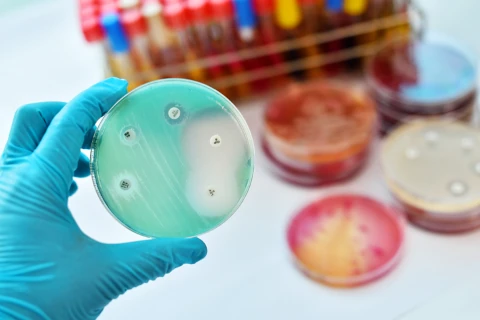How to Treat Resistant Staphylococcus aureus (MRSA)
What is Staphylococcus Aureus?
Staphylococcus aureus, commonly known as Staphylococcus Aureus, is a Gram-positive bacterium, a family of bacteria with a thick, rigid cell wall, similar to streptococci, enterococci, and Listeria. Staphylococcus aureus is naturally present in various areas of the human environment and hence in humans (in the air, on the ground, in water, etc.). It is estimated that 30 to 40% of the population carries staph bacteria on their skin, in their sinuses, and in their mucus… National Library of Medecine : https://www.ncbi.nlm.nih.gov/books/NBK441868/
In small quantities, they cause no symptoms. However, when staph bacteria invade a place they shouldn’t be or multiply too much, they can become pathogenic, leading to an “infection” diagnosis.
Though often present without causing disease, it can suddenly cause skin infections, urinary tract infections, wound infections, and bone and joint infections in individuals with a weakened immune system or damaged skin. In some people, the infection can lead to sepsis.
What can Staph bacteria infect?
Staph bacteria can infect all parts of the human body. However, certain parts are more at risk or statistically more affected:
- Sinus infection
- Skin infection
- Bone infection (osteitis)
- Urinary tract infections
- Lung infections
- Etc.
How do we get infected by Staph bacteria?
- During fatigue, illness, stress, etc., the immune system is less effective, and the risk of infection is greater.
- During operations or invasive procedures in the hospital, we then speak of nosocomial infections.
- Accidents often lead to staph infections by passing the bacteria from the epidermis (skin) to the bone during slides that abrade the flesh.
The risks of these types of infection should be taken very seriously. Indeed, they can lead to amputation or even death with the development of sepsis (generalized infection). Staphylococcal bone and joint infections are very common.
Antibiotic treatment
To treat this infection, it is essential to receive appropriate medical treatment promptly. Doctors usually administer antibiotic treatment orally or by intravenous injection, depending on the severity of the infection. However, doctors are noting significant progress in this bacterium’s resistance to antibiotics, making it increasingly difficult to treat. Thus, different treatment may need to be considered for staph strains resistant to antibiotics, such as MRSA (Methicillin-Resistant Staphylococcus Aureus).
Staphylococcus resistance to antibiotics.
The resistance of staphylococcus bacteria to antibiotics is increasing. Indeed, antibiotics have eradicated most antibiotic-sensitive staph. Thus, the surviving staph are not sensitive to antibiotics. This is called “selection pressure.” An antibiotic-resistant staph is called MRSA: Methicillin-Resistant Staphylococcus Aureus.
Also, staphylococcus, like other bacteria, can create a biofilm to protect itself. These biofilms act as shields, which antibiotics can’t penetrate.
The first step in treatment in the West will consist of antibiotic treatment decided by the infectious disease specialist. However, given the increasing importance of these bacteria’s antibiotic resistance, antibiotic treatments are increasingly ineffective (aside from the well-known harmful side effects of antibiotics).
How to treat antibiotic-resistant aureus staph?
Phage therapy to treat antibiotic-resistant aureus staph
Phage therapy is an alternative treatment method that utilizes viruses known as bacteriophages to combat bacterial infections. This approach is recommended by the National Library of medecine for treating antibiotic-resistant Staphylococcus Aureus: Bacteriophage Therapy for staphylococcus Aureus infections. Bacteriophages are viruses that specifically infect bacteria, destroying them from the inside. Phage therapy has been successfully used in Eastern Europe and Asia for decades. However, it is not yet widely accepted in the Western world. Phage therapy is employed to treat infections caused by antibiotic-resistant Staphylococcus Aureus. Specific bacteriophages that target this bacterium are administered. Bacteriophages can be given by injection or orally, depending on the severity of the infection.
Phage therapy has the advantage of being highly targeted, only killing the target bacteria without damaging other beneficial bacteria in the body. Additionally, it is used to treat antibiotic-resistant infections, making it a treatment option when antibiotics are ineffective.
Phage therapy is a flexible and adaptable treatment method. Bacteriophages can be cultured specifically to treat infections caused by a given strain of antibiotic-resistant Staphylococcus Aureus. Furthermore, bacteriophages can be genetically modified to enhance their effectiveness against antibiotic-resistant bacterial strains.
Once antibiotic resistance is observed, it is essential not to wait for the situation to worsen. Swiftly resorting to the last option—a phage therapy treatment—remains the most effective way to heal. Phages can adapt to their targets and can penetrate biofilms. Understanding the difference between the modes of action of phages and antibiotics is crucial. Visit the following page: Comparison of phages and antibiotics.
In the case of staphylococcal infections, the results are exceptional and without side effects.
Phage therapy treatment for Staphylococcus aureus depends on the infected site: sinus rinsing with phages, wound cleaning with phages, injection of phages into the fistula, prosthesis cleaning with phages, urethral infiltration of phages for urinary tract infections, etc.
To understand how a phage therapy treatment works, visit the page “Phage Therapy Treatment”.
To understand phage therapy treatment in the case of osteoarticular infections: “Phage therapy and osteoarticular infections“.
Treating antibiotic-resistant Staphylococcus aureus with Colloidal Silver
Although the internal use of colloidal silver is prohibited in the West, many people consider it a natural alternative to antibiotics. Additionally, it is widely recognized to have numerous advantages when used externally.
Colloidal silver, a colorless liquid, consists of microscopic silver particles suspended in distilled water. It has antimicrobial and antiseptic properties, making it a popular remedy against bacterial, viral, and fungal infections.
While the internal use of colloidal silver is prohibited in the west, some people use it as a dietary supplement to boost the immune system and fight internal infections. However, it should be noted that this use is not scientifically proven and may pose health risks.
External use of colloidal silver is more widespread and considered safe and effective. It is often used as a disinfectant for cuts, burns, insect bites, and rashes. It can also be used to clean wounds and promote healing.
Colloidal silver is a natural solution containing small particles of silver suspended in pure water. This solution has been used for centuries to combat infections and has recently been rediscovered for its antibacterial and antiviral properties. Colloidal silver can be used to treat skin infections caused by Staphylococcus aureus by applying it directly to the skin. It works by disrupting the bacteria’s cell membrane, leading to their death. This action is particularly effective against Staphylococcus aureus, which can be difficult to treat with antibiotics. Colloidal silver can also stimulate the immune system to help fight the infection. However, it is important not to overuse it. Excessive use can lead to side effects such as argyria (a blue skin disease caused by an excess intake of silver particles) and kidney problems.
Propolis for treating Antibiotic-resistant Staphylococcus Aureus
Propolis is produced by bees and is a substance with interesting properties for treating infections. Propolis is a resinous substance crafted by bees that serves as mortar and antiseptic to protect their colony from diseases and infections. It has many therapeutic virtues, including healing, antifungal, antibacterial, and antiseptic properties, and can be consumed in various forms to treat different diseases.
It is particularly effective in treating antibiotic-resistant Staphylococcus aureus. Indeed, propolis possesses antimicrobial and anti-inflammatory properties. Propolis is used in the form of an ointment or a solution that is applied directly to the infected area. Propolis helps reduce inflammation, relieve the infected area, and accelerate healing and wound closure. It can also be ingested orally, in the form of drops or capsules. Propolis can be mixed with water or juice for easier consumption.

